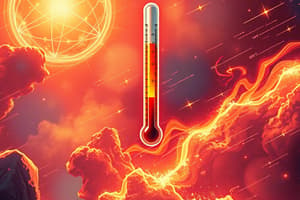Podcast
Questions and Answers
Which system of units is the modern standardization used in most scientific disciplines?
Which system of units is the modern standardization used in most scientific disciplines?
- Traditional system
- Metric system
- SI system (correct)
- Imperial system
When converting units, what is essential in various fields like cooking, manufacturing, and engineering?
When converting units, what is essential in various fields like cooking, manufacturing, and engineering?
- Using random conversion formulas
- Adding digits together
- Ignoring the unit labels
- Multiplying or dividing by a conversion factor (correct)
What is the primary purpose of the International System of Units (SI)?
What is the primary purpose of the International System of Units (SI)?
- To complicate scientific measurements
- To facilitate international communication and ensure consistency (correct)
- To ensure inconsistency within the scientific community
- To confuse international communication
In the SI system, what is the base unit for temperature?
In the SI system, what is the base unit for temperature?
Which unit is commonly used to measure mass in the metric system?
Which unit is commonly used to measure mass in the metric system?
What makes converting units crucial in various fields?
What makes converting units crucial in various fields?
What is the ratio to convert inches to centimeters?
What is the ratio to convert inches to centimeters?
Which measurement tool is used for measuring mass?
Which measurement tool is used for measuring mass?
In which countries were imperial units traditionally used?
In which countries were imperial units traditionally used?
What is the base structure of the metric system characterized by?
What is the base structure of the metric system characterized by?
How do you convert grams to pounds?
How do you convert grams to pounds?
Which system has become the standard in most scientific and technical fields worldwide?
Which system has become the standard in most scientific and technical fields worldwide?
Flashcards are hidden until you start studying
Study Notes
Units and Measurement
When we talk about the world around us, measuring and comparing things is an essential part of our everyday lives. From determining the distance to the grocery store to analyzing the composition of a new compound in science, our ability to quantify and communicate measurements lies at the heart of modern civilization. In this article, we'll explore the concepts of SI units, converting units, imperial units, and measurement tools, with a focus on the metric system.
The International System of Units (SI)
The International System of Units, or SI, is the modern standardization of units used in most scientific disciplines. It was first established in 1960 as a means to facilitate international communication and ensure consistency within the scientific community. The SI system consists of seven base units (length, mass, time, electric current, temperature, amount of substance, and luminous intensity), as well as derived units like force, area, and volume.
Converting Units
While most scientific disciplines rely on the SI system, it's not the only measurement system in use. To bridge the gap between different units of measurement, we must be able to convert one unit to another. Conversions from traditional units to SI units or among traditional units are essential in various fields like cooking, manufacturing, and engineering.
Converting units often involves taking a given value expressed in a base unit and multiplying or dividing it by a conversion factor. For instance, to convert inches to centimeters, you'd multiply by 2.54 (the ratio between inches and centimeters). To convert grams to pounds, you'd divide the grams by 453.6.
Imperial Units
Imperial units are a set of measurement units traditionally used in the United Kingdom and some other English-speaking countries. The most well-known imperial units include inches, feet, pounds, and gallons. Although these units are still used in some industries and everyday life, the SI system has become the standard in most scientific and technical fields worldwide.
Measurement Tools
A variety of tools exist to help us measure the world in a precise and reliable manner. The most commonly used tools include:
- Rulers: Long, straight, and flat, these are used for measuring length on flat surfaces.
- Tape measures: Flexible, retractable, and often marked with inches and centimeters.
- Vernier calipers: Used for measuring small distances, thicknesses, or diameters precisely.
- Hydrometers: Utilized to measure the specific gravity, density, or mass concentration of liquids.
- Thermometers: To measure temperature, both in liquid and gas forms.
- Balances: For measuring mass, typically in grams or kilograms.
- Scales: For measuring weight, often in pounds or kilograms.
The Metric System
The metric system, developed in France during the 18th century, is another widely used system of measurement. The metric system's base units are derived from natural constants like the speed of light and the size of the Earth's orbit. This system is characterized by its base-10 structure, making calculations and conversions easier and more accurate.
In conclusion, understanding units and measurement systems, including the SI, imperial, and metric systems, is crucial for accurately describing and understanding the world around us. With the proper tools and a fundamental grasp of conversion factors, we can confidently communicate measurements and calculations across disciplines and cultures.
Studying That Suits You
Use AI to generate personalized quizzes and flashcards to suit your learning preferences.




